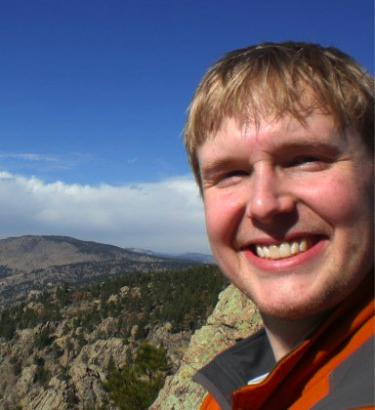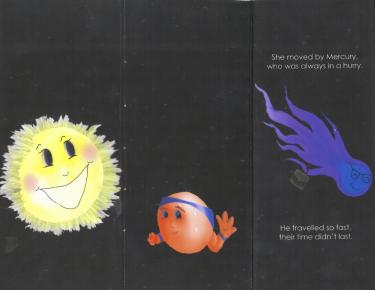Students in CU-Boulder science-writing class write science-themed books for first graders, who now return the favor
Two first graders walk into a class. They open a science book they wrote together. They read it to college students, who clap and ask questions.
This is no joke. It’s a joint effort of a writing class at the University of Colorado Boulder and a first-grade class at Bear Creek Elementary School.
More on that later. But first, back to the story. It concerns a grizzly bear and a polar bear, both famished after a harsh winter, both eyeing a “luscious elk.”
The first-grade girl ticks off the grizzly’s diet, size and top speed—35 mph. The boy narrates a parallel tale about the polar bear—25 mph, if you’re curious. The tension peaks as both animals lunge at the hapless elk.
The grizzly runs faster, so it wins. The fate of the polar bear is left to the readers’ imagination.
Daniel Long calls this a “great example of community-based writing.” He should know. Long, who earned his MA in English literature at CU-Boulder, teaches “Writing on Science and Society” for the university’s Program for Writing and Rhetoric.
A few years ago, one of his students, Allyson Adams, asked to write a science-themed children’s book for her final project. Her book is called Our Love Was Born from Burning Stars, and it offers a scientific, as opposed to religious or mythological, account of the universe’s origins.
During the next two semesters, more and more students asked to write children’s books, Long recalls. “So I said to myself, ‘Why not ask all of them to write children’s books?’”
As long as you’re writing children’s books, you might as well share them with actual children. Long did this via Stephanie Briggs, a first-grade teacher at Boulder’s Bear Creek Elementary School.
Long’s students read their books to Briggs’ first graders last spring, and the kids asked if they could write their own books. After two more classes made the same request, “Mrs. Briggs and I said to ourselves, ‘Why not let them?’”
This spring, the first graders at Bear Creek Elementary wrote and illustrated their own books. Their assignment: to tell a story based on imaginary contests between two animals—and the assignment was appropriately called “Who Would Win?” The matchups included a mako shark vs. a great white shark, badger vs. wolverine, cheetah vs. leopard and great horned owl vs. golden eagle.
A page from The Lost Wolf and the Sleepy Moon, by CU-Boulder students Will Golding, Chris LeSueur, Hanadi Salamah and Perry Soderstrom. Click on picture for larger image.
Framing the assignment as a wild competition prodded the first graders to learn about the animals in their stories. Thereby hangs both a tale and a bit of science.
Who Would Win is a popular series of children’s books written by Jerry Pallotta and illustrated by Rob Bolster. Briggs asked teams of first graders to research two animals on specific characteristics using library books and child-friendly websites.
The first graders incorporated writing strategies they learned during the year: using vivid details, interesting word choices, sound effects and similes, Briggs notes. And the kids enjoyed it.
“They were thrilled to share their efforts with Danny Long’s students, who inspired them to use science concepts to create engaging stories,” Briggs says.
Long’s CU-Boulder students, meanwhile, have also been writing, illustrating and binding children’s books that tell engaging stories with a subtext of science, sometimes conveyed through anthropomorphic characters.
I love the assignment for a number of reasons: it’s multimodal, it demands critical and creative thinking, it teaches students how to engage in deliberative dialogue, is stresses audience awareness, it discourages wordiness.”
To illustrate the hydrologic cycle, for instance, Long’s students chronicled the journey of Reggie, the raindrop. Highlighting anatomy, students told the story of a human heart who’s feeling blue because only the brain came to the heart’s birthday party. (The brain helps the bone, tooth and stomach overcome their weaknesses and join the celebration.)
There’s Halley, the lonely comet who finds solace as she soars by the solar system’s planets, each with its own character. And there’s The Lost Wolf and The Sleepy Moon, which follows a little wolf as he howls at a moon that changes shape during a month—thus highlighting the lunar cycle.
A section of a fold-out book titled Halley (One lonely comet visits her friends), by CU-Boulder students Lucy Wilkinson, Christina Clementz, Girish Narayanswamy and Eric Brown. Click on picture for larger image.
The groups of students who wrote and illustrated these books include the following: David DeHerrera, Brock Bylovas and Nicci Hines created Reggie. Nate Coyle, Lu Cester, Evan Lockard and Sachi Wong wrote the anatomy story. Lucy Wilkinson, Christina Clementz, Girish Narayanswamy and Eric Brown wrote and illustrated Halley. And Will Golding, Chris LeSueur, Hanadi Salamah and Perry Soderstrom created Lost Wolf.
Long is particularly pleased that his science-writing students have observed something many writers never see: a real impact. He puts it this way:
“It’s the latest of my attempts to disassemble the walls enclosing the science-writing curriculum. I want my students to look their influence in the eye, to see that their writing matters: it teaches, it awes, it inspires.”
Long’s course aims to help students practice techniques for communicating analytically and persuasively, to further develop their creative and critical-thinking skills, and to consider how their fields relate to other fields and to the civic arena.
Besides those skills, the course also imparts bookbinding methods. This is thanks to CU-Boulder’s Department of Special Collections and Archives. “The librarians there have played a vital role in teaching my students bookbinding methods,” Long says. “Halley, for example, wouldn’t exist without SCA’s book-arts instruction.”
In an essay published last summer, Long discussed his fondness for the children’s-book exercise. “I love the assignment for a number of reasons: it’s multimodal, it demands critical and creative thinking, it teaches students how to engage in deliberative dialogue, is stresses audience awareness, it discourages wordiness,” he wrote.
“And above all, it’s fun! Really flippin’ fun!”
Clint Talbott is director of communications and external relations for the College of Arts and Sciences and editor of the College of Arts and Sciences Magazine.






